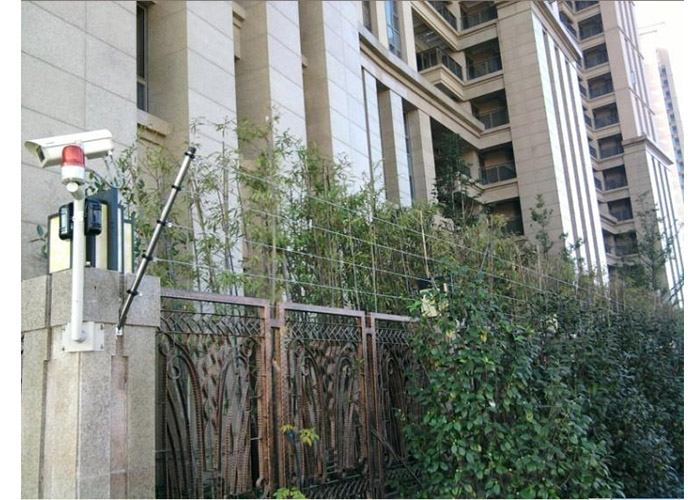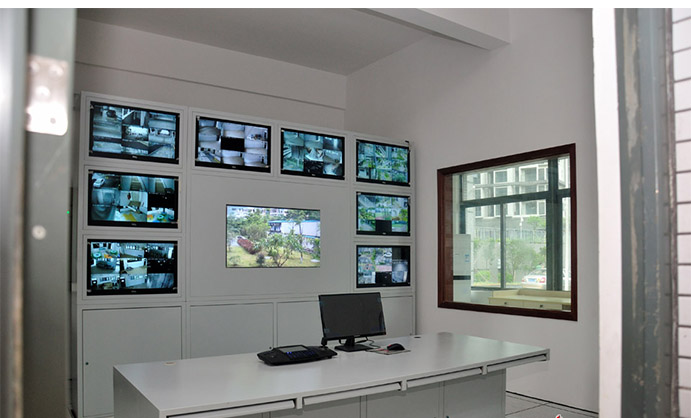
1) CCTV closed-circuit television monitoring system (including front-end camera, power supply, shield, bracket, line, back-end hard disk video recorder, matrix host, monitor, display, control host and software maintenance, etc.)
2) Building automation system (including control host, DDC controller, module, sensor, power supply, circuit, and software maintenance, etc.)
3) Intrusion alarm system (including control host, alarm host, defense zone module, sound and light alarm, alarm button, door sensor, infrared detector and software maintenance, etc.)
4) Wireless patrol system (including host, collector, patrol point and software maintenance)
5) Access control system (including access control host, elevator controller, gate controller, access control controller, power supply, wiring, electric lock, card reader and software maintenance, etc.)
6) Public broadcasting/fire emergency broadcasting system (including broadcasting amplifier, system manager, call station, DVD, deck, end speaker, tuning switch and software maintenance, etc.)
7) Parking lot management system (including toll collection system, entrance and exit cameras, control host, gates, ticket machines, IC card sensors, ticket boxes, on-site indicators, ticket printers and software maintenance, etc.)
8) Information release system (including release host, information release screen, line and software maintenance, etc.)
9) Building intercom system (unit host, indoor extension, management center host, etc., Kunshan Monitoring and Installation Company

(1) Maintenance rules
Implement strict management of each system, set up resident maintenance personnel on site, and establish a complete on-duty system and maintenance rules. The on-duty personnel should carefully monitor the operating status of the system, record abnormal conditions at any time, and report for repairs in time. Suzhou Monitoring and Installation Company
1. According to the relevant national norms and requirements, send professionals to regularly check, test, maintain and repair the system to ensure the normal operation of the equipment.
(1) Check the maintenance items no less than once a week. And fill in the inspection records, find faults in a timely manner to eliminate or repair, and as a basis for assessment and maintenance work.
(2) The system status is checked once a month, 12 times a year.
(3) The maintenance items shall be inspected no less than once a quarter. If there is a fault or problem, it should be eliminated and repaired in time.
2. It is necessary to provide a 24-hour maintenance phone number, and accept the owner's service request at any time 24*365 days; after receiving the owner's service request, the on-site resident personnel will maintain the site in time. If the problem is still not resolved, professional engineers will be sent to the site within 8 hours.
(1) After the maintenance technicians diagnose the fault, they will be divided according to the degree of urgency, and the solution will be submitted within 8 hours at the latest.
(2) After the maintenance technicians arrive at the site, they need to continue to work until the equipment is in normal operation. General faults should be repaired within 24 hours; if it is necessary to wait for the purchase of accessories or the equipment itself cannot be repaired in time, it must be reported to the owner immediately, and Take appropriate emergency measures. During this period, the system shall not be interrupted for more than 12 hours.
(3) After the system or equipment is repaired, it must be confirmed by relevant personnel of Party B.
3. Equipment replacement: If it is necessary to purchase or replace equipment or accessories during the maintenance process, it shall be reported to the owner in advance, and the repair or replacement can be carried out only after the owner's representative signs and confirms. This part of the cost is not within the scope of Party B. If Party B needs to replace the equipment or accessories immediately for emergency repair in order to ensure the normal operation of the system or equipment, it must report to the owner in time after the event, and the damaged parts after replacement should be checked by Party A. The model parameters of the replaced equipment (or components) shall not be lower than the model parameters of the original equipment (or components), and shall be recorded in the equipment maintenance (replacement) record sheet.
4. The maintenance unit should submit a detailed work plan and work arrangement to the owner, make a careful record of each inspection and maintenance work, and hand it over to the owner's relevant personnel for signature.
5. The maintenance unit should effectively strengthen on-site management to ensure safe production. In the event of personal, equipment and third-party accidents during the maintenance and repair, Party B shall not bear any responsibility. Kunshan Monitoring and Installation Company
6. The maintenance unit shall not inquire or download relevant information, and shall not disclose Party B's work secrets. The staff of the maintenance unit enter the owner's unit to carry out maintenance work, and must abide by the owner's relevant rules and regulations and obey the management of the owner's unit.

3. Maintenance goals
CCTV CCTV monitoring system:
1. Inspection items and objectives:
(1) Front-end equipment: Suzhou Monitoring and Installation Company
(a) Camera: image quality, viewing angle, image clarity;
(b) Pan mirror control: pan tilt horizontal and vertical rotation; lens focus, focus, aperture adjustment functions; decoder working status;
(c) Protective cover and support system: airtight condition, firmness, and whether it is corroded;
(2) Transmission system:
(a) Signal transmission line: line connection status, signal transmission attenuation, insulation resistance, and no line interference;
(b) Lightning protection device: whether the grounding connection is firm, and whether the resistance value of the grounding resistance conforms to the national standard;
(3) Central control room:
(a) Whether the functions of hard disk video recorder, video recording, front-end control, image display, parameter debugging, etc. are normal: (b) Monitor: whether the image display is clear, and whether the screen debugging function is working normally;
(c) Control equipment: whether the working state is normal;
2. Inspection time: The front-end equipment is inspected once a month, and the transmission system and the central control room are inspected once a quarter. Temporary fault repair processing, and timely processing after receiving the notice from the property company.
(2) Intrusion alarm system
1. Inspection items and objectives:
(1) Front-end equipment:
(a) Alarm button: whether the installation is loose, whether the alarm speaker is working, and whether the power supply is in place.
(b) Defense zone module: whether the power supply is normal, whether the wiring is reliable, and whether the communication is normal.
(c) Door sensor: Whether the device is working normally.
(2) Transmission system:
(a) Signal transmission line: line connection status, signal transmission attenuation, insulation resistance, whether there is no line interference, terminal, module and host communication status.
(3) Access control system (including access control, elevator control and gate system)
1. Inspection items and objectives:
(1) Front-end equipment:
(a) Card reader: whether the installation is loose, whether the power supply is in place, and whether the card reading is normal.
(b) Electric lock: whether the power supply is normal, whether the wiring is reliable, and whether the communication is normal.
(c) Exit button: Whether the device is loose and whether the device is working properly.
(2) Transmission system:
(a) Signal transmission line: line connection status, signal transmission attenuation, insulation resistance, whether there is circuit interference, terminal, controller and host communication status.
(3) Central control room: Check whether the card issuer, online equipment status, elevator control usage period and other functions are normal.
(4) Wireless Patrol System
1. Inspection items and objectives:
(1) Front-end equipment:
(a) Patrol: Check whether the fixed base installed is loose and whether the information points are missing.
(b) Collector: whether the battery is normal and whether the collection point is normal.
(c) Transmitter: Whether the equipment is working normally and whether the communication is normal.
(2) Transmission system:
(a) Signal transmission line: line connection status, communication status of collector, transmitter and host.
(3) Central control room: whether each patrol route and software programming are normal.
(5) Building automation system
1. Inspection items and objectives:
(1) Front-end equipment:
(a) Sensor: Check whether the power supply of each sensor device is normal and whether the device installation is loose.
(b) DDC: Whether the module installation is firm, whether the power supply is normal, whether the wiring terminals are loose, and whether the grounding is normal.
(c) Each control box of electromechanical: whether the wiring terminals in the box are neat and reliable.
(2) Signal transmission line: line connection status, signal transmission attenuation, insulation resistance, whether there is no line interference, terminal, controller and host communication status.
(3) Central control room:
(a) Whether each control schedule works normally, and each sensor device displays;
(b) Detecting whether each main software function can be realized, controlling the process, and;
(6) Garage management system;
1. Inspection items and objectives:
(1) Front-end equipment:;
(a) Card reader: whether the installation is loose, whether the power supply is in place, and whether the card is read;
(b) Barrier: whether the power supply is normal, whether the wiring is reliable, whether the communication is not;
(c) Ground induction coil: whether the equipment is working normally and whether it is linked with the gate;
(d) Camera: whether the camera angle is appropriate and whether the power supply is normal;
(e) Ticket collection machine and ticket inspection machine: whether the power supply is normal, whether the wiring terminals are reliable, and whether the communication is working normally.
(2) Transmission system: signal transmission line: line connection status, signal transmission attenuation, insulation resistance, whether there is circuit interference, terminal, controller and host communication status.
(3) Central control room: whether each workstation and server is working normally, whether the card issuer, online equipment status, charging system, indicating the number of parking spaces in the venue, whether data recording and storage are normal, and whether the software is working normally.
(7) Information release system
1. Inspection items and objectives:
(1) Front-end equipment:
(a) Release screen: Whether the fixed base installed is loose, and whether the screen display is normal.
(b) Remote player: whether the power supply is normal, whether the communication with the host is normal, and whether the storage is normal.
(2) Transmission system: signal transmission line: line connection status, player and host communication status.
(3) Central control room: whether the software works normally, whether the communication at each point is normal, and whether the remote transmission is normal.
(8) Announcement broadcasting and emergency broadcasting system
1. Inspection items and objectives:
(1) Front-end equipment:
(a) Speaker: Whether the installation is loose and whether it is working properly.
(b) Volume controller: whether the installation is firm, and whether the volume adjustment function is.
(2) Transmission system: signal transmission line, line connection status, signal transmission attenuation, insulation resistance, and no line interference.
(3) Central control room: Whether the main equipment (amplifier, DVD, deck, controller) of the computer room is working normally, and whether the fire fighting linkage is normal.
(9) Building intercom system
1. Inspection items and objectives:
(1) Intercom host
(a) Whether the host installation is firm
(b) Is the call extension and management center normal?
(2) Management host
(a) Whether the mainframe, extension, and wall machine of the call unit of the management center are normal
(b) Whether the authorization of the management software is normal, and whether the database is normal
